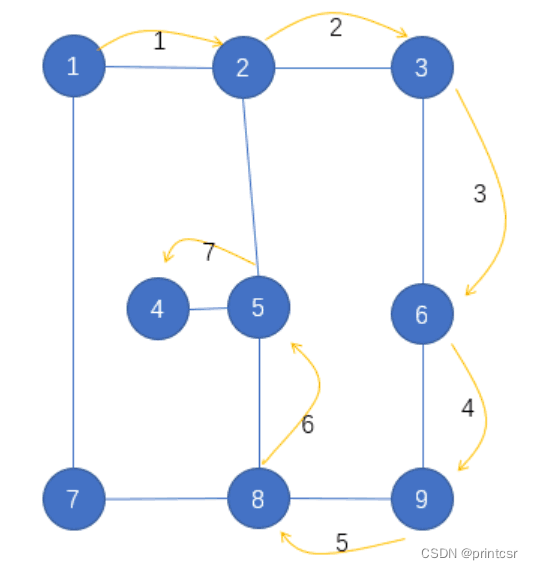1.图的定义
”“
图是一种比线性表和树更为复杂的数据结构。 它是由顶点的有穷非空集合和顶点之间边的集合组成,通常表示为:G(V,E),其中,G表示一个图,V是图G中顶点的集合,E是图G中边的集合 。图结构,是研究数据元素之间的多对多的关系。在这种结构中,任意两个元素之间可能存在关系。即结点之间的关系可以是任意的,图中任意元素之间都可能相关。 图是由顶点的有穷非空集合和顶点之间边的集合组成,通常表示为:G(V,E),其中,G表示一个图,V是图G中顶点的集合,E是图G中边的集合。
""
2.代码实现
#include <stdio.h>
#include <malloc.h>
#define QUEUE_SIZE 10
int* visitedPtr;
typedef struct GraphNodeQueue{
int* nodes;
int front;
int rear;
}GraphNodeQueue, *QueuePtr;
QueuePtr initQueue(){
QueuePtr resultQueuePtr = (QueuePtr)malloc(sizeof(struct GraphNodeQueue));
resultQueuePtr->nodes = (int*)malloc(QUEUE_SIZE * sizeof(int));
resultQueuePtr->front = 0;
resultQueuePtr->rear = 1;
return resultQueuePtr;
}
bool isQueueEmpty(QueuePtr paraQueuePtr){
if ((paraQueuePtr->front + 1) % QUEUE_SIZE == paraQueuePtr->rear) {
return true;
}//Of if
return false;
}
void enqueue(QueuePtr paraQueuePtr, int paraNode){
printf("front = %d, rear = %d.\r\n", paraQueuePtr->front, paraQueuePtr->rear);
if ((paraQueuePtr->rear + 1) % QUEUE_SIZE == paraQueuePtr->front % QUEUE_SIZE) {
printf("Error, trying to enqueue %d. queue full.\r\n", paraNode);
return;
}
paraQueuePtr->nodes[paraQueuePtr->rear] = paraNode;
paraQueuePtr->rear = (paraQueuePtr->rear + 1) % QUEUE_SIZE;
}
int dequeue(QueuePtr paraQueuePtr){
if (isQueueEmpty(paraQueuePtr)) {
printf("Error, empty queue\r\n");
return NULL;
}
paraQueuePtr->front = (paraQueuePtr->front + 1) % QUEUE_SIZE;
printf("dequeue %d ends.\r\n", paraQueuePtr->nodes[paraQueuePtr->front]);
return paraQueuePtr->nodes[paraQueuePtr->front];
}
typedef struct Graph{
int** connections;
int numNodes;
} *GraphPtr;
GraphPtr initGraph(int paraSize, int** paraData) {
int i, j;
GraphPtr resultPtr = (GraphPtr)malloc(sizeof(Graph));
resultPtr -> numNodes = paraSize;
resultPtr -> connections = (int**)malloc(paraSize * paraSize * sizeof(int));
resultPtr -> connections = (int**)malloc(paraSize * sizeof(int*));
for (i = 0; i < paraSize; i ++) {
resultPtr -> connections[i] = (int*)malloc(paraSize * sizeof(int));
for (j = 0; j < paraSize; j ++) {
resultPtr -> connections[i][j] = paraData[i][j];
}
}
return resultPtr;
}
void initTranverse(GraphPtr paraGraphPtr) {
int i;
visitedPtr = (int*) malloc(paraGraphPtr -> numNodes * sizeof(int));
for (i = 0; i < paraGraphPtr -> numNodes; i ++) {
visitedPtr[i] = 0;
}
}
void depthFirstTranverse(GraphPtr paraGraphPtr, int paraNode) {
int i;
visitedPtr[paraNode] = 1;
printf("%d\t", paraNode);
for (i = 0; i < paraGraphPtr -> numNodes; i ++) {
if (!visitedPtr[i]){
if (paraGraphPtr -> connections[paraNode][i]) {
depthFirstTranverse(paraGraphPtr, i);
}
}
}
}
void widthFirstTranverse(GraphPtr paraGraphPtr, int paraStart){
int i, j, tempNode;
i = 0;
QueuePtr tempQueuePtr = initQueue();
printf("%d\t", paraStart);
visitedPtr[paraStart] = 1;
enqueue(tempQueuePtr, paraStart);
while (!isQueueEmpty(tempQueuePtr)) {
tempNode = dequeue(tempQueuePtr);
visitedPtr[tempNode] = 1;
i ++;
for (j = 0; j < paraGraphPtr->numNodes; j ++) {
if (visitedPtr[j])
continue;
if (paraGraphPtr->connections[tempNode][j] == 0)
continue;
printf("%d\t", j);
visitedPtr[j] = 1;
enqueue(tempQueuePtr, j);
}
}
}
void testGraphTranverse() {
int i, j;
int myGraph[5][5] = {
{0, 1, 0, 1, 0},
{1, 0, 1, 0, 1},
{0, 1, 0, 1, 1},
{1, 0, 1, 0, 0},
{0, 1, 1, 0, 0}};
int** tempPtr;
printf("Preparing data\r\n");
tempPtr = (int**)malloc(5 * sizeof(int*));
for (i = 0; i < 5; i ++) {
tempPtr[i] = (int*)malloc(5 * sizeof(int));
}
for (i = 0; i < 5; i ++) {
for (j = 0; j < 5; j ++) {
printf("i = %d, j = %d, ", i, j);
printf("%d\r\n", tempPtr[i][j]);
tempPtr[i][j] = myGraph[i][j];
printf("i = %d, j = %d, %d\r\n", i, j, tempPtr[i][j]);
}
}
printf("Data ready\r\n");
GraphPtr tempGraphPtr = initGraph(5, tempPtr);
printf("num nodes = %d \r\n", tempGraphPtr -> numNodes);
printf("Graph initialized\r\n");
printf("Depth first visit:\r\n");
initTranverse(tempGraphPtr);
depthFirstTranverse(tempGraphPtr, 4);
printf("\r\nWidth first visit:\r\n");
initTranverse(tempGraphPtr);
widthFirstTranverse(tempGraphPtr, 4);
}
int main(){
testGraphTranverse();
return 1;
}
3.深度优先遍历
深度优先搜索 就是从一个顶点开始,沿着一条路径一直搜索,直到到达该路径的最后一个结点,然后回退到之前经过但未搜索过的路径继续搜索,直到所有路径和结点都被搜索完毕同样的,概念比较抽象,我们用例子模拟一遍深度优先搜索,如图所示,先随便沿着一条路径一直搜索,图中路径为 1 -> 2 -> 3 -> 6 -> 9 -> 8 -> 5 -> 4

当搜索到 4时,发现查找不到未被访问的顶点了,因此 4就是这条路径的最后一个顶点,此时我们要往后倒退,找寻别的每搜索过的路径.此时发现当往后退到 8 时,有一条路径上还有未被搜索过的顶点,即 8 -> 7.沿着这条路径一直找到了最后一个顶点—— 7,此时我们要继续往后退,看看还有没有别的路径没走过并且有未搜索过的顶点,发现此时所有顶点都被访问过了,也就意味着一个完整的深度优先搜索就完成了。





















 994
994











 被折叠的 条评论
为什么被折叠?
被折叠的 条评论
为什么被折叠?








